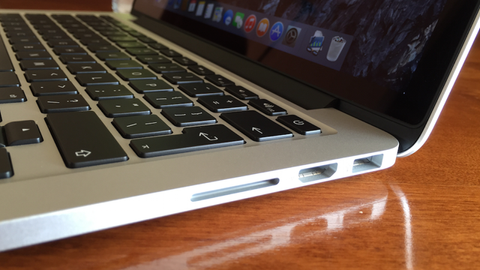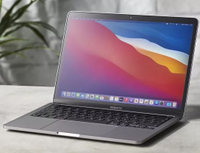TechRadar Verdict
The 2014 13-inch MacBook Pro was arguably Apple's best laptop, and the 2015 model is better still. If your next MacBook needs to be reliable, powerful and practical, the newest MacBook Pro is the only way to go.
Pros
- +
Retina Display
- +
Faster processor
- +
Superb battery life
Cons
- -
Force Touch underdeveloped
- -
Unchanged design
- -
Base storage feels small
Why you can trust TechRadar
The new MacBook Pro (late 2020) is powered by Apple's first laptop processor, the M1. Benchmarks show that it makes a wonderful mobile workstation, a jaw dropping music production notebook and a groundbreaking video editing laptop.
The New MacBook has grabbed most of the headlines in recent weeks, but Apple has refreshed some of its MacBook Pros and MacBook Airs too — except for one.
While the 15-inch MacBook Pro is waiting for Intel's newest Core i7 processors, the 13-inch Retina MacBook Pro has received some changes that make it a significant upgrade. An upgrade to Intel's newest Broadwell CPU, along with a pressure-sensitive Force Touch Trackpad are the most significant of the lot.
Recent developments
Nearly a year and a half after its initial release, the MacBook Pro 13-inch with Retina display (early 2015) is finally due for an upgrade. The MacBook Pro 2016 is rumored to be announced at Apple's September 7 event with a hard release shortly thereafter. Apple's new professional-grade laptops will come fully stocked with more powerful 6th-generation Skylake processors, USB 3.1 Gen 2 ports and potentially even TouchID.
On the other hand, if you would prefer to stick with your current MacBook Pro setup, support certainly isn't slowing down. At WWDC 2016, Apple revealed macOS Sierra, the Siri-enhanced successor to OS X 10.11 El Capitan of yesteryear. The new operating system will be supported by these systems. The announcement was subsequently followed up by a beta released to the public on July 7, 2016.
macOS Sierra comes decorated with a handful of improvements that rethink the way you use your MacBook Pro. The newly open-source Siri, for instance, has been ported over with a few notable differences from its mobile counterpart. Not only will you be able to ask her (or him) the usual questions such as, "What's the weather like?," but now the virtual assistant can help you locate files and manage your disk space in ways that were previously unnecessary or impractical.
Other new features you'll soon be able to experience with your year-plus-old MacBook Pro include Universal Clipboard for copying/cutting/pasting across different Apple hardware, unlocking your MacBook Pro using an Apple Watch, improved photo categorization and – finally – Apple Pay.
Moreover, MacBook Pro excitement from third-party accessory makers hasn't ceased either. While one company has made multitasking a breeze with a triple-monitor expansion for laptops, another startup is aiming to make your present MacBook Pro configuration more capable using an external graphics solution, a useful tool for trying out the best Mac games.
In an attempt to cash-in on the back-to-school season, Apple is finding its own ways to push MacBook sales without the advent of new hardware. With the right credentials, you could save up to 15% on a brand-new MacBook as a student or educator if you buy right now.
Sure, Apple will inevitably phase out the MacBook Pro 13-inch with Retina display (early 2015) at some point, but even then, its legacy will not be forgotten. That's especially the case if you're, for some reason, repulsed by the move to USB Type-C, as we're unlikely to see an alternative to the new interface style on the next MacBook Pro given Apple's recent history with the 12-inch MacBook.
Luckily, you may still have a 5K standalone monitor to look forward to even without buying a new Mac.
Design
On the outside, it's business as usual. The 13-inch Macbook Pro hasn't had a radical redesign, and its shape, dimensions, weight and port configurations are identical to the outgoing model. That means two Thunderbolt 2 ports, a USB 3.0 port, a headphone jack and a MagSafe 2 port on the left, and a second USB 3.0 port, SDXC card slot and HDMI 1.4 port on the right.
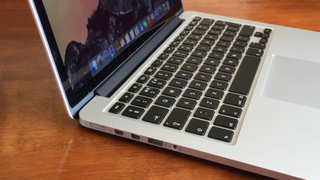
The screen resolution is 2,560 x 1,600 pixels, but you actually get the screen real-estate of a 1,280 x 800 pixel-resolution display due to the pixel-doubled effect that provides Retina-like sharpness. Apps like SwitchResX allow you to access even higher resolutions than OS X allows, stretching all the way up to 3,360 x 2,100.
Text is too tiny to be legible at that setting, but opting for one in-between, such as 1,920 x 1,200, lets you fit much more of spreadsheets and other apps into the display than any of the default screen resolutions at the expensive of clarity.
Still, even on the four default resolutions there's plenty of room for even the most screen-intensive pro apps, and OS X Yosemite's divisive design looks much better on Retina displays than it does on lower density screens.
It's a shame that Apple hasn't shaved even a millimetre or two off the MacBook Pro with Retina's chassis. The 2013 MacBook Pro with Retina was 25% thinner than its predecessor, and it made a huge difference to that machine's portability and overall appeal. Sure, Apple has outed the new MacBook which will attract the thin-and-light laptop die-hards, but those of us requiring power, ports and all of the rest would have still appreciated a slightly slimmer model.
Feel the force
The only external change is something you can't see: the way the trackpad works. The MacBook Pro has a new, non-mechanical Force Touch trackpad, which provides tactile feedback and can detect various levels of force. For example, you might press to fast-forward a video and press harder to speed it up more.
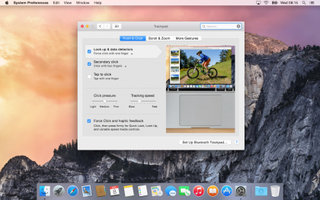
For now, the haptic feedback simply replicates the feeling of clicking a mechanical trackpad (something it does perfectly – you really feel like you're pressing a real button), but over time Apple is likely to find other uses for the pressure sensitive technology. You can adjust the sensitivity of the trackpad and the strength of its feedback in System Preferences, and while you're there you might want to re-enable the three-finger drag; it's switched off by default now.
Interestingly, Apple hasn't put its new MacBook keyboard into the Pro models just yet, so you get the familiar chiclet keys with a scissor mechanism underneath. To our fingers they aren't as comfortable as the non-chiclet keyboards in the first Intel MacBook Pros, but maybe we're just being nostalgic. Nevertheless, if you're all about the typing, the MacBook Air is a little more comfortable.
There are three standard models to choose from, priced at £999 ($1,299 over in the US, which is around AU$1,690), £1,199 ($1,499 over in the US, which is around AU$1,950) and £1,399 ($1,799 over in the US, which is around AU$2,340).
Each model has a Broadwell processor: a 2.7GHz dual-core fifth-generation Core i5 in the £999 and £1,199 models and a 2.9GHz dual-core Core i5 in the most expensive option. The 2.7GHz processors can run at up to 3.3GHz in Turbo Boost mode, and the 2.9GHz processor can run at up to 3.4GHz. The model we tested was the stock £999, 2.7GHz one.
All three processors come with 3MB of shared L3 cache and 8GB of 1,866MHz LPDDR3 RAM, and they're teamed with 128, 256 or 512GB of PCIe-based flash storage and Intel Iris Graphics 6100. Previous MacBook Pros had Iris Graphics 5100, and Apple claims 20% to 40% improvements in graphics performance.
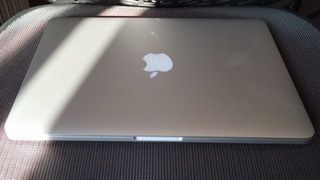
Spec list
Here is the full spec sheet:
- CPU: 2.7GHz dual-core Intel Core i5 with 3MB L3 cache (Turbo Boost up to 3.1GHz)
- Graphics: Intel Iris Graphics 6100
- RAM: 8GB
- Screen: 13.3-inch IPS, 2,560 x 1,600 pixels
- Storage: 128GB SSD
- Optical Drive: n/a
- Ports: 2 x Thunderbolt 2, 2 x USB 3.0, SDXC card slot, HDMI, headphone
- Connectivity: 801.11ac Wi-Fi and Bluetooth 4.0
- Camera: FaceTime HD
- Weight: 3.48lbs (1.58kg)
- Size: 12.35 x 8.62 x 0.71-inches (W x D x H)
You can also specify a built-to-order MacBook Pro with a 3.1GHz dual-core Core i7 (with boost to 3.4GHz) with 4MB of shared L3 cache, up to 16GB of RAM and up to 1TB of flash storage. Assuming you're customising the 2.9GHz model, those upgrades cost £170 (around $250, or AU$325), £160 (around $235, or AU$305), and £400 (around $590, or AU$770) respectively.
The MacBook Pro's battery has been improved too. On paper it doesn't look like much – it's a 74.9Wh battery compared to its predecessor's 71.8Wh – but the new MacBook Pro delivers significantly improved battery life. Apple claims 10 hours of wireless web browsing and 12 hours of iTunes movie playback.
Last but not least there's 802.11ac Wi-Fi and Bluetooth 4.0, which deliver Apple-specific features such as AirDrop file transfer and Continuity/Handoff communication with iOS apps and communications.
The MacBook Pro is significantly faster than its predecessor, and while we still wouldn't recommend the 13-inch MacBook Pro (or any other machine with integrated graphics) for serious gaming, our benchmarks show that graphics performance has improved.

Here's how the MacBook Pro 13-inch with Retina display fared in our benchmark tests:
Benchmarks
- Cinebench R15 Single Core: 124 cb; Multi Core: 310 cb
- Geekbench 3 Single Core: 3287; Multi Core 7107
- Xbench (CPU and disk): 491.26
- NovaBench Overall: 41; Graphics: 95;
- Unigine Heaven 4.0 FPS: 21.3; Overall: 41
- Battery, streaming 1080p video via Wi-Fi: 12 hours 4 minutes
The MacBook Pro with Retina comfortably beat the equivalent 13-inch model from 2014 in all benchmarked areas. In Xbench, which provides an indication of a Mac's overall performance, it came in at 9% faster than the 2014 model's Haswell variant. Geekbench, which tests the CPU, saw the new MacBook score 7,107 points on the multi-core test compared to its predecessor's 6,852.
The new MacBook has seen an upgrade from Intel Iris Graphics 5100 to Iris Graphics 6100, which includes an increased number of execution units (48 to 40) but sees clock speed reduced from 1200 to 1100MHz. In NovaBench, it scored 95 in the Graphics test versus lat year's 79, signalling an 18% improvement.
Even with improved integrated graphics onboard, the MacBook Pro remains a poor choice for serious gamers. It will certainly be capable of running older titles at 60Hz in a Boot Camp installation on Windows (think games using Valve's Source engine — such as Counter Strike and TF2), but don't expect anything like Battlefield: Hardline to play smooth as butter.
The biggest surprise was the battery, which was still happily streaming 1080p video over Wi-Fi after more than twelve hours. It finally ran out of puff after a truly impressive twelve hours and four minutes. Not everybody is happy with the new 13-inch MacBook Pro's performance, however. Some users have reported UI lag and significant battery drain.
Bundled software
As with all new Macs the MacBook Pro comes with Apple's own iWork and iLife apps, including:
iPhoto (soon to be replaced with Photos)
- iMovie
- Garageband
- Pages
- Numbers
- Keynote
- Safari
- Messages
- FaceTime
- Calendar
- Contacts
- App Store
- iTunes
- iBooks
- Maps
- Photo Booth
- Time Machine
The MacBook Pro hasn't undergone a dramatic reimagining, but then there wasn't anything particularly wrong with it in the first place. Improvements to its performance mean it's better value than before, and the noticeably improved battery life makes it even more of a mobile workhorse.
As ever the cost of adding memory and storage soon sends the price tag into orbit, but even the stock £999 ($1,299 over in the US, which is around AU$1,690) MacBook Pro is an incredibly versatile computer and arguably Apple's best ever laptop. The new MacBook may be more portable, but the Pro has all the power.
We liked
Apple has taken an already impressive laptop and made it better. It's faster, it lasts longer and the screen is superb. It'll be interesting to see whether the Force Touch trackpad gets any must-have applications too.
We disliked
We're not huge fans of current Mac laptop keyboards, and for now the Force Touch trackpad feels more like a gimmick than anything particularly useful – it isn't making the MacBook Pro any thinner or lighter and doesn't have any compelling reason to exist just yet. If you haven't embraced the (i)Cloud, 128GB of storage may feel a little constrained too.
Final verdict
Where the new MacBook sacrifices performance and ports for portability, the MacBook Pro makes no such compromises. It's lightweight enough that you needn't fear a dislocated shoulder from lugging it around, and the improved performance and battery life will delight road warriors and coffee shop loungers alike.
It's more expensive than an Ultrabook – for example, Dell's excellent XPS 13 is almost half the price – and the non-Retina MacBook Pro is £100 (around $150, or AU$190) cheaper, but the former won't tempt OS X fans and the latter means going without that superb screen. We wouldn't. Unless you need serious storage, the 13-inch MacBook Pro offers an incredible amount of bang for your bucks.
Writer, broadcaster, musician and kitchen gadget obsessive Carrie Marshall (Twitter) has been writing about tech since 1998, contributing sage advice and odd opinions to all kinds of magazines and websites as well as writing more than a dozen books. Her memoir, Carrie Kills A Man, is on sale now. She is the singer in Glaswegian rock band HAVR.

I got a Dolby Atmos soundtrack mixing demo at Sony Pictures Studios, and now I know how Spider-Man sounds get made
Today's Wordle answer is the hardest this year, with an average score of 5.4, and 'Wordle 1037 X' is trending on Twitter – here's why it's so tough and what to do in future

JLab JBuds Lux ANC review: budget headphones that are all about that bass
